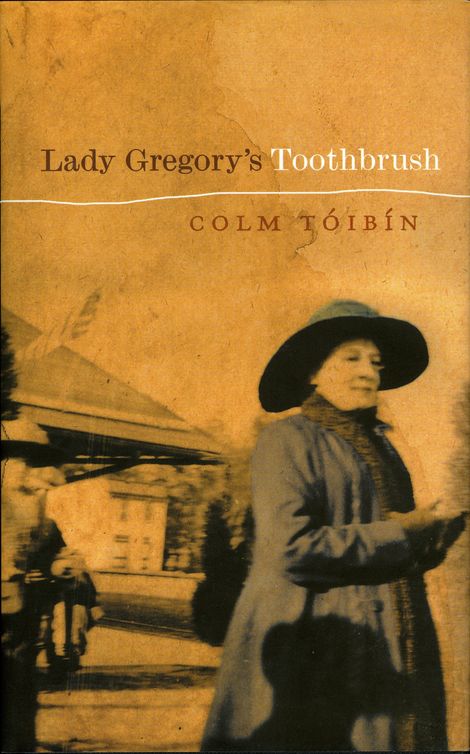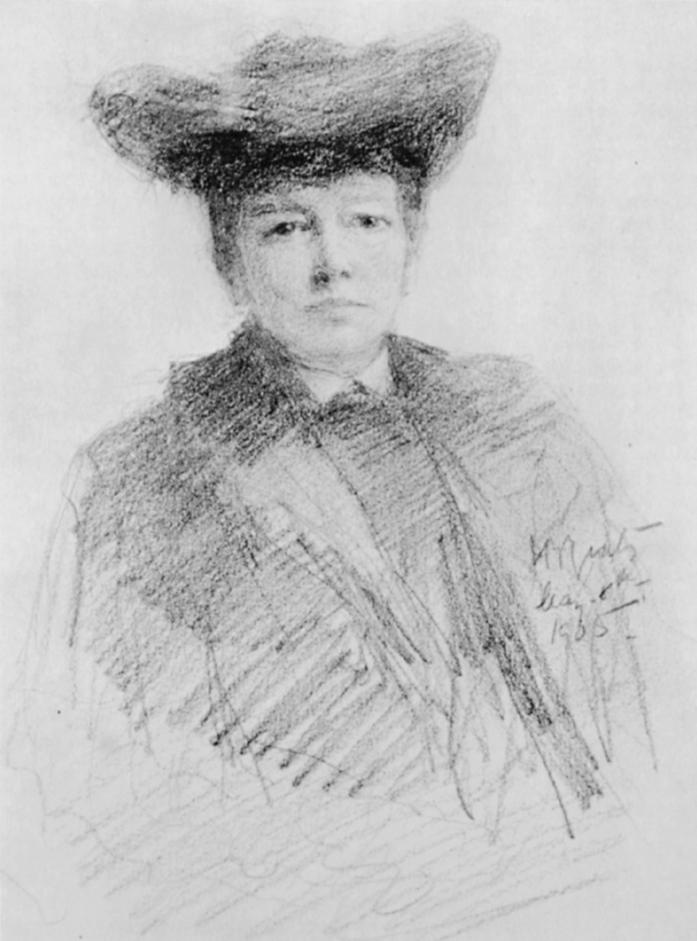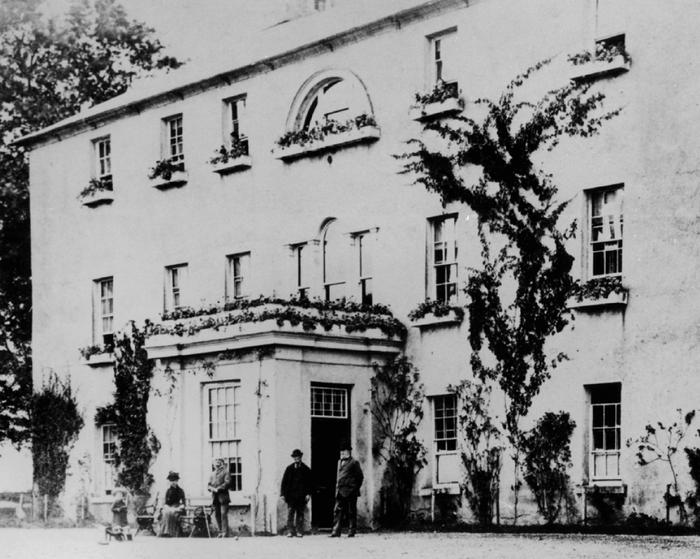Lady Gregory's Toothbrush
Read Lady Gregory's Toothbrush Online
Authors: Colm Toibin



COLM TÃIBÃN
DUBLIN
for Dympna Hayes
I
n 1933, a year after her death, in his book
The Winding Stair and Other Poems
, Yeats published his two great poems about Lady Gregory. He described her old age in “Coole Park and Ballylee, 1931”:
Sound of a stick upon the floor, a sound
From somebody that toils from chair to chair;
Beloved books that famous hands have bound,
Old marble heads, old pictures everywhere;
Great rooms where travelled men and children found
Content or joy; a last inheritor
Where none has reigned that lacked a name and fame
Or out of folly into folly came.
In “Coole Park, 1929” he contemplated Coole's legacy and the legacy of his old friend:
They came like swallows and like swallows went,
And yet a woman's powerful character
Could keep a swallow to its first intent;
And half a dozen in formation there,
That seemed to whirl upon a compass-point,
Found certainty upon the dreaming air,
The intellectual sweetness of those lines
That cut through time or cross it withershins.
The house is indeed gone, but there is no shapeless mound, there are no nettles. Coole did not meet the fate of other such houses in the period between 1918 and 1924. It was not burned; it was not attacked by the locals. It was sold to the Forestry Commission of the new Irish state, and in turn, after the old woman's death in 1932, it was sold to a local builder who demolished it. The site where it stood is now cemented over. But the famous tree where the famous carved their initials is still there, and it is still
possible
to make out the letters, from WBY and JBY to JMS and SOC and AE to GBS and, indeed, some others, less famous, both locals and visitors.
The house where Augusta Gregory was born,
Roxborough
, just seven miles away, was burned down in the Civil
War. Soon after the fire, on 8 October 1924, she went to look at it: “The house, the ruin is very sad,” she wrote in her journal, “just the walls standing, blackened, and all the long yards silent, all the many buildings, dairy, laundry, cowhouses, coach houses, stables, kennels, smithy, sawmill and carpenter's workshop empty, some of the roofs falling in.” “This is a sad day to the whole of us,” Sean O'Casey wrote to her. “The ruins of all these lovely houses
constitute
a desolate monument of shame to Irish humanity.” The estate Lady Gregory's family had run for many
generations
was divided into one hundred and twenty
smallholdings
, each, as one of her early biographers noted, “with its own neat grey box of a house”.
Â
S
he was born Augusta Persse in 1852, the youngest girl in a large family followed by four boys. In 1914, when George Moore in his autobiography attempted to suggest that she was “an ardent soul gatherer in the days gone by but abandoned missionary work when she married”, she vehemently denied this in a letter to his publisher. “My mother and my two eldest sisters”, she wrote, “thought it right to point out what they believed to be the different teaching of the Bible to that of the Catholic church to any Catholics who would listen. They made no secret of this proselytism which was much mixed up with benevolence
and charity in those days, and my sister,
Mrs Shawe
-
Taylor
, especially, worked ardently for its accomplishment ⦠I myself, the youngest, shrank from any effort to shake or change the faith of others.”
She was brought up in a strict and rigid Protestantism with much Bible-reading and devotion to duty. Her mother held strong views on what or who was unsuitable for her daughters. This included the reading of novels, and extended to John Lane, whom her sister Adelaide
eventually
married, and her cousin Standish Hayes O'Grady, the distinguished translator from the Irish, whom her mother, believing that cousins should not marry, banned from the house.
Lady Gregory's sisters were taller than her and had greater accomplishments in the art of finding a suitable partner. Augusta was considered the plain one, destined to be the carer, the spinster, whose type was depicted in
A Drama in Muslin
, George Moore's novel of Anglo-Irish decay set ten years later. In 1879, however, while
accompanying
her mother and her brother, who was ill, to Nice, she renewed her acquaintance with their neighbour Sir William Gregory, a widower, who owned Coole Park. He was thirty-five years older than her, he had been a member of parliament for both Dublin and Galway and had also been Governor of Ceylon. Unlike her own family, he did not farm his Irish estate or live fully on its proceeds. He
lived mainly in London, where he was a Trustee of the National Gallery. He was interested in books and
paintings
and, when he came to Ireland, he gave her the run of his library at Coole. She read
Roderick Hudson
under his
auspices
, and
Middlemarch
. In 1880 she married him.
The house he took her to, and the life he gave her in their twelve years of marriage, and indeed his own
connections
and history, offered her a rich set of associations. At school in Harrow, he had sat beside Anthony Trollope. “He was a big boy,” Sir William Gregory wrote in the
Autobiography
which Lady Gregory edited after his death, “older than the rest of the form, and without exception the most slovenly and dirty boy I ever met. He was not only slovenly in person and in dress, but his work was equally dirty ⦠These peculiarities created a great prejudice against him and the poor fellow was generally avoided ⦠He gave no sign of promise whatsoever, was always in the lowest part of the form, and was regarded by masters and by boys as an incorrigible dunce.”
In the early 1840s, when Trollope was working for the Post Office in the Irish midlands forty miles from Coole, he renewed his acquaintance with Gregory and was a guest in the house. At twenty-five, Gregory had become an M.P. and was a great favourite among the political hostesses in London and indeed, for some time, was a protégé of Prime Minister Peel himself. “As Gregory's guest in Coole,”
VictoriaÂ
Glendinning has written, Trollope “listened to the social and political gossip and did not forget it ⦠It was the best possible fodder for a novelist ⦠It was the
politics
and the sexual scandals of the 1840s, when he knew almost no one, which were to be the starting-points for his fiction long after he left Ireland.”

William Gregory introduced Trollope to many of the leading writers and politicians. Trollope repaid the
compliment
by using aspects of Gregory, his popularity and his promise in the London of those years, in the creation of the character of Phineas Finn. In 1875, when Gregory, to
his own disappointment, had reached the pinnacle of his career as Governor of Ceylon, Trollope stayed with him for two weeks.
Despite the birth of their only child, Robert, in 1881, Sir William Gregory and his young wife spent a great deal of time in the 1880s travelling. They left their son at home, and this caused her much pain. Within a short time of her marriage she met Henry James in Rome, and later, in
London
, Robert Browning, Tennyson, James Russell Lowell, Mark Twain and many other writers and politicians and hostesses who were in Sir William's circle. Her accounts of those years are observant and wry. “I sat next to Henry James,” she wrote, “and being in the middle of reading âThe Portrait of a Lady', asked why he had let Isabel marry that odious husband Osmond. He said she was bound to do something foolish, and I said yes with all that money. âBut without it,' he said, âwhere would have been the story? Besides, it is delightful for a poor man being able to bestow large fortunes on his heroines.'”
Lady Gregory's most important and enduring
relationship
of those years began in Egypt in December 1881. Wilfrid Scawen Blunt, a handsome English poet and
anti-imperialist
, was travelling in Egypt with his wife, a
granddaughter
of Byron. Both couples became interested in Egyptian nationalism and especially in the fate of Arabi Bey, the Egyptian leader who sought a degree of freedom
from the control which Britain and France exercised over his country. Blunt and Gregory began to write letters to
The
Times
, whose editor was a friend of Gregory's, and their arguments went against the grain of British official policy. This made Blunt immensely happy. He loved foreign causes, but as the British government became more alarmed, Sir William, a pillar of the establishment all his life, slowly withdrew support. On 19 May 1882 Blunt wrote in his journal: “Gregory has failed us.” Blunt continued to cajole, write letters and raise money. And Lady Gregory remained on his side. According to her diaries, Sir William said to her: “You and Wilfrid talk more nonsense than any two people settling the affairs of the world, and as old Mrs â said of the two English Commissioners sent to
investigate
the potato disease âThere isn't a hap'worth of sense in both your blocks.'” To win support for Arabi in England, Lady Gregory wrote an account of visiting his house and meeting his wife and children. Sir William gave her
permission
to publish it, and then withdrew permission as Arabi's forces were defeated by the British, and then restored permission when Arabi faced possible execution. It was her first published work, printed in
The Times
and later separately as a pamphlet.
Â
T
he Gregorys spent the summers in Coole and the rest of the year travelling or in London. Lady Gregory kept a diary of her reading, she visited the poor, she enjoyed society. She remained an imperialist in these years, attacking Gladstone's assertion “that England without colonies would be as powerful as she is now” with
elaborate
argument. “He would probably also tell his gardener”, she wrote in her notebook, “that a tree repaying by shade and shelter the nutriment drawn from the soil by its wide spreading roots would flourish and perform its function equally well if confined in a flower pot.”
She seemed eager to impress Blunt and also to keep him at a distance, as he extended his anti-imperialist
sympathies
. In October 1883 she wrote to him: “Sir William writes to me from London that you are credited with
having
gone to India with the intention of overthrowing
English
supremacy and establishing Mahommedan rule and rapine throughout the peninsula, so I think you still have a chance of Tower Hill.” From Coole she wrote: “The poor people come to the door daily, believing that I can cure them of all diseases, including poverty, and I mix their cough cures and buy their flannel and dye it with madder in an iron pot, and altogether I am at present one of the happy people without a history.” But she did have a history, and as Blunt became more involved in the cause of Irish land reform, ending up in prison in Galway for his pains,
her history gave them grounds for disagreement: “Called on Lady Gregory,” he wrote, “who is growing very bitter against my politics, if not against me. It is curious that she, who could see so clearly in Egypt ⦠should be blind now that the case is between English landlords and Irish tenants in Galway. But property blinds all eyes, and it is easier for a camel to pass through the eye of a needle, than for an Irish landlord to enter the kingdom of Home Rule.”
Sir William died in March 1892. Lady Gregory's tone in her journal entry in January 1893, when she
remembered
his death and his funeral, was grave, full of sharply remembered moments. “At Gort [near Coole],” she wrote, “the people met him at the train & carried him to the Church & went into the service â And next morning the tenants came, & attended service again, old Gormally kneeling by the coffin all the time â Snow was falling & there were few able to come from a distance â but all the poor were there.” In between describing these events, she wrote: “Oh my husband! Do you know how little I have forgotten you!” By temperament and upbringing she was skilled in the art of “dutiful self-suppression”, in James Pethica's phrase, and skilled too in the art of discretion. It is
possible
that nobody noticed anything special or peculiar in the twelve sonnets entitled “A Woman's Sonnets” which
Wilfrid
Scawen Blunt published at the end of January 1892, just over six weeks before Sir William Gregory's death. In
his diary he wrote: “I have remodelled Lady Gregory's twelve sonnets, which I heard from her a day or two she would like to see printed in the new book, though of course without her name. They are really most touching and required little beyond strengthening here and there a phrase and altering a few recurrent rhymes.”
